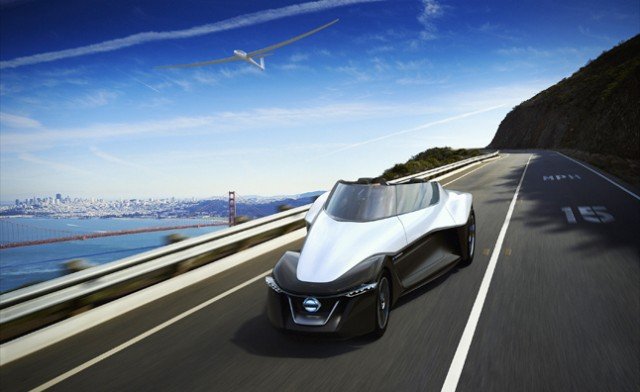Nissan BladeGlider to be unveiled at Tokyo Motor Show 2013
Nissan plans to reveal the new deltoid-shaped BladeGlider concept vehicle at the upcoming 43rd edition of Tokyo Motor Show.
The way the prototype gets its power is as revolutionary as the design itself.
While the DeltaWing used a small but high-performance gasoline engine, the BladeGlider is all-electric. But unlike Nissan’s now-familiar Leaf battery-electric vehicle, the new concept vehicle puts power to the pavement through a pair of in-wheel motors.
The Tokyo Motor Show, which opens November 22, has a history of providing show-goers with wild, weird and wacky concept vehicles. But unlike most of the prototypes unveiled at the biennial event, Nissan is broadly hinting that the BladeGlider could reappear in production form in the not-too-distant future.
The concept vehicle’s shape, with its long, tapered nose and broad rear, immediately brings to mind a fighter jet and, in a sense, the two have much in common, as automotive designers have come to realize that improving aerodynamics can significantly reduce fuel consumption, improve performance and enhance vehicle stability, especially at high speeds.

Nissan plans to reveal the new deltoid-shaped BladeGlider concept vehicle at the upcoming 43rd edition of Tokyo Motor Show
To give perspective to the radical design, the BladeGlider measures just 3.3 feet at the front, but 5.9 feet in the rear. Like the DeltaWing, the concept’s front wheels are relatively close together, though the rear tires are positioned in the more classic automotive layout.
The approach might seem to defy conventional automotive logic as the BladeGlider has a 30/70 front-to-rear weight distribution, in sharp contrast to the 50/50 layout considered ideal for today’s cars. Meanwhile, the extensive use of lightweight carbon fiber reduces vehicle weight, improves the concept’s rigidity and helps sculpt a design with significant high-speed downforce.
The interior is laid out in an unusual 1+2 configuration, with two passengers sitting slightly to the rear of the driver. When the doors are opened, the driver’s seat swings out of the way to allow access to the rear seats.
BladeGlider was penned by Ben Bowlby, who also drafted both the DeltaWing and the Zero-Emission On Demand, or ZEOD, racer Nissan will sponsor in the 2014 race at Le Mans. He was inspired by both the F14 fighter jet and the elegant shapes of high-performance gliders.
But Nissan’s clean sheet approach doesn’t stop with the BladeGlider’s design. The powertrain could prove just as revolutionary.
Instead of using an electric motor that simply replaces a conventional gasoline engine under the hood, Nissan is using twin motors, one mounted inside each of the rear wheels. That approach has a number of potential advantages. Among other things, it eliminates the need for a bulky engine compartment. It moves power directly to the wheels and makes it possible to adjust the torque coming out of each driven wheel. In turn, that makes it possible to “vector” torque to help steer through corners.
[youtube YRlDcGiBpuU 650]
